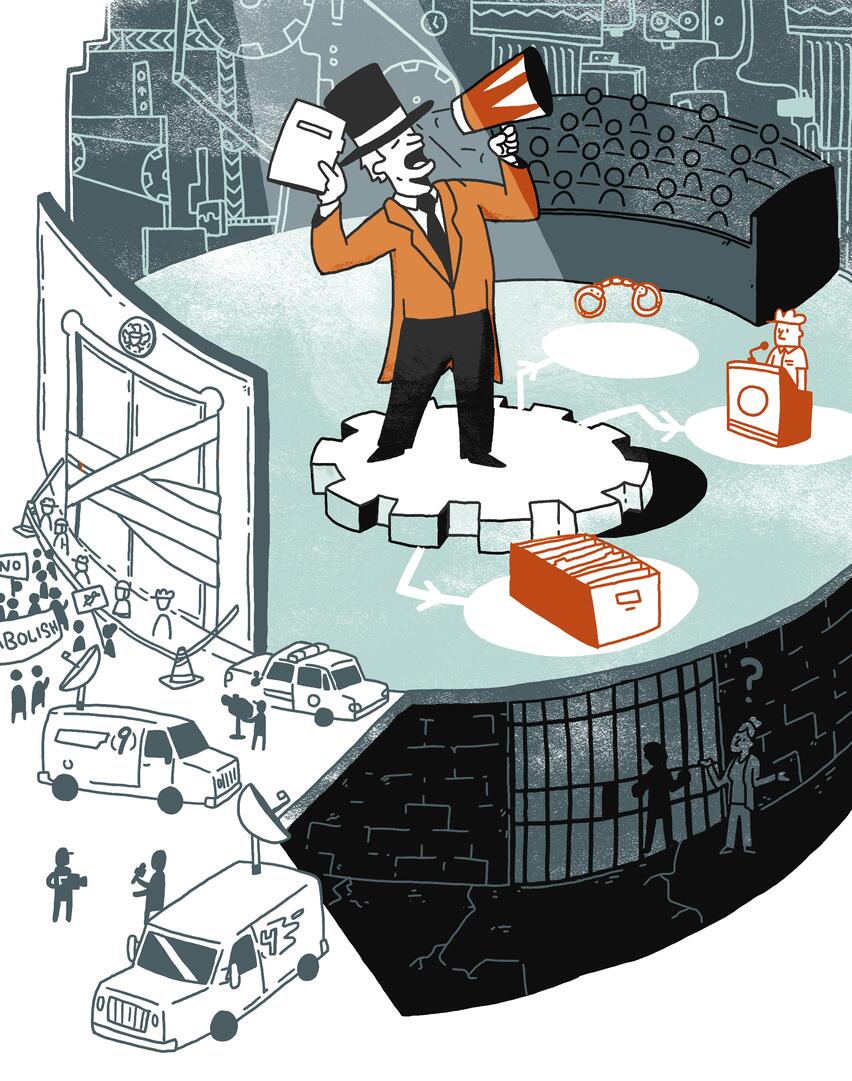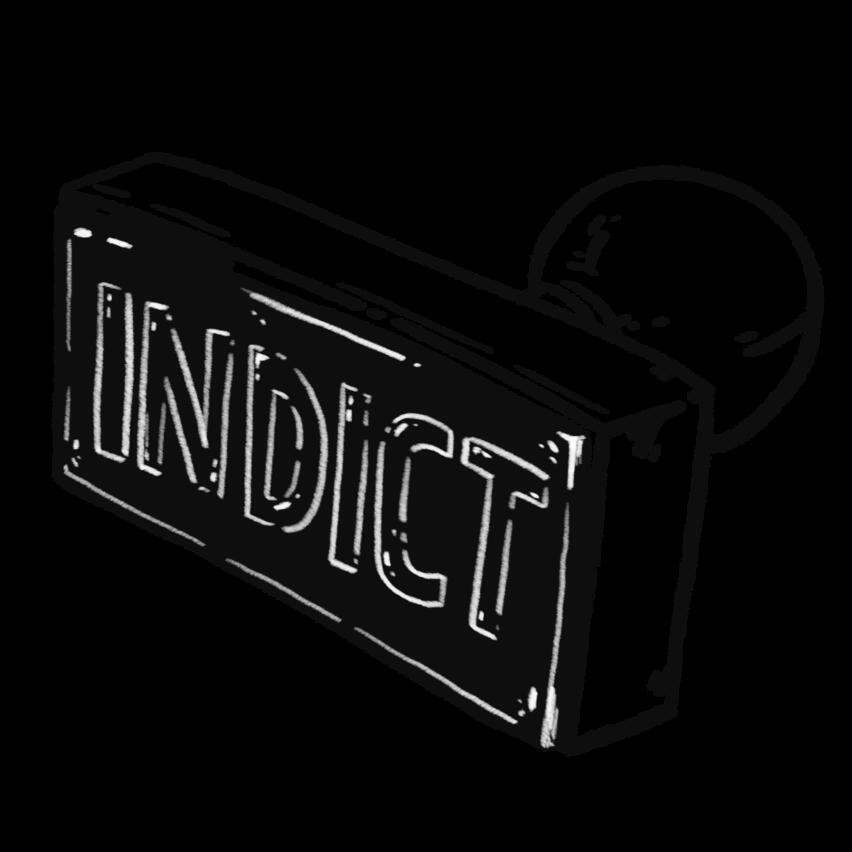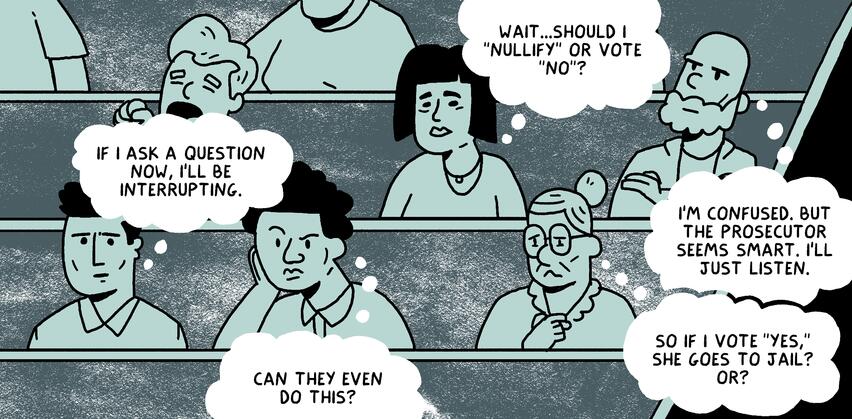Grand Jury / Preliminary Hearing
The next step after arraignment is a decision about whether there is enough evidence—probable cause—to move forward with the charges/prosecution. Depending on the place and what crimes someone is being charged with, this determination can happen through a grand jury and/or a preliminary hearing.
Whether the decision is made by a grand jury or a judge at a preliminary hearing, there is a very low bar to establishing probable cause so it is easy for a prosecutor to get the approval to continue with prosecution.
First, let's tackle grand juries.
The grand jury is a one-sided proceeding where the prosecutor presents evidence to a group of people selected from the public, known as the grand jurors. The defense is not allowed to participate in the grand jury. The grand jurors decide whether the prosecutor has probable cause for an indictment, which is necessary for the case to move forward. If the grand jury does not find that there is probable cause to support the charges, it has to issue what is called a “no true bill,” and the charges will be dropped.
The grand jury normally hears many cases in quick succession for the duration of their service, which can last for weeks or months. People receive notices in the mail that they must come to court to serve on a grand jury. They serve for a period of time, and during that time, the jurors hear evidence, receive instructions about the law, and then are asked to vote on whether or not the evidence is sufficient to establish that a crime has occurred.
Here is how one person described her time on a grand jury in New York City:
“Prosecutors come in one-by-one with their individual cases and lay out the evidence to the grand jury—usually in the form of witnesses, documents, and surveillance video—for anywhere from 15 minutes to several hours. We probably heard between five to seven prosecutors each day.
Defendants have a right to testify, should they want to, but their lawyers can only advise them, not make arguments on their behalf. Once the grand jury has heard all the evidence, a prosecutor reads the charges and their definitions out loud. A court reporter is tap-tap-tapping away.
Then the grand jury is left alone to discuss the evidence and vote. If 12 of 23 people find that there is “legally sufficient evidence” and see “reasonable cause to believe” that a person did what they are accused of, the jury indicts. An indictment is not a judgment of guilt or innocence. But it clears the way for that question to be decided in a plea deal or trial.”
Grand juries are different from trial juries. A trial jury decides whether the evidence is enough to establish beyond a reasonable doubt that a person committed a crime. A grand jury decides, based only on information the prosecutor presents, whether there is enough evidence to go forward with the case because they believe, again only based on information that prosecutor presents, that it is more likely than not that a crime occurred and that the person accused was responsible for it. That is a very low burden of proof.
Illusion:

The grand jury is supposed to create a limit on the prosecutor’s power by making them prove to a jury that they have the legal basis for pursuing charges.
Reality:

That is not how it functions in practice. In most places, the prosecutor decides everything about the grand jury. It is the prosecutor’s show and their objective, generally, is to get an indictment.
They have control over (1) What charges to present; (2) What legal guidance to offer about how the grand jury should make its decision; (3) Which witnesses to present; and (4) Whether to go forward with the grand jury in the first place. Prosecutors want an indictment, and grand jurors usually agree. There is a reason we have the saying that most grand juries will indict a ham sandwich.
Illusion:

Grand jurors have the power to keep prosecutors in check.
Reality:

While grand jurors do technically have the power to nullify and to ask questions of the witnesses, they often are not informed of this power (called jury nullification).
Additionally, it is actually a very radical and difficult move for a lay person, in the face of a judge, a prosecutor, court officers, other jurors, and general societal conditioning, to vote no in the face of obvious probable cause. Even asking probing questions can feel difficult and is often discouraged.
Consider the testimony of Mimi Swartz, a woman who sat on a grand jury in Harris County, Texas, and described her experience in a New York Times op-ed:
“We duly became rubber-stamp artists. And I might have continued to indict away on autopilot if it hadn’t been for two fellow jurors: a young black lawyer and a white former judge.
As cases came and went, I couldn’t help noticing that their questions seemed to annoy the prosecutors: They were gumming up the works. But they were raising legitimate issues. Was it right to indict someone for carrying an almost microscopic quantity of marijuana after he had been stopped and arrested for “walking on the street when a sidewalk was provided”? ...When we asked to interview additional witnesses in a complicated child sexual abuse case, we met resistance. At one point, a young prosecutor accused by the former judge of withholding evidence burst into tears.
Why was it seen as troublesome that our jury asked searching questions or sought more time to study thick case files of serious crimes? Maybe it was a coincidence, but after a while, the tough cases seemed to go to other grand juries. Suddenly, shoplifting came up a lot.”
Illusion:

Grand juries are transparent hearings where both sides are able to present their side of the story.
Reality:

Grand jury proceedings happen entirely in secret. No members of the public or media are allowed to attend. Not even the person accused of a crime nor their defense team can be present, except the person accused of the crime can be present to testify (and only during the time they are testifying). It is very rare for an accused person to testify since their lawyer cannot ask questions and you are not able to be present to hear what other witnesses say. The grand jury is a one-sided presentation.
There are many paths to prosecution, and grand jury presentation and indictment is just one. Not all states use grand juries. Each of the 23 states that do use grand juries does so differently. Some states use it for felonies, others for a range of cases, including even misdemeanor cases.
Okay so what about preliminary hearings?
In some places, instead of grand juries, or in addition to the grand jury, there is a preliminary hearings (sometimes called probable cause hearings) that both the defense and prosecution attend. The purpose is similar to the grand jury: to decide whether the prosecutor has enough proof to charge a person with a crime. However, instead of a jury, that decision is up to a judge or magistrate. During a preliminary hearing, the prosecution will bring witnesses, usually police officers, and the defense can ask questions.
Illusion:

Preliminary hearings are more fair because the defense team can actually attend and participate. The defense can try more explicitly to get the charges dismissed, whereas in the grand jury it’s a black box—they have no idea what is going on.
Reality:

In both grand juries and preliminary hearings, police officers are the star witnesses, and are typically seen as more credible than anybody else. The defense may be leery of presenting their full case at the preliminary hearing because there are so many unknowns at this early stage, and don’t want to risk showing their hand to the prosecutor, giving them an advantage.
Key takeaways

- Probable cause is a very low burden of proof and so it is very easy for a prosecutor to get an indictment and continue with prosecution.
- The grand jury functions as a rubber stamp, not as a check on the prosecutor’s power.
- Jurors do have the power to nullify charges, although they are often not informed of this power and it can be difficult in practice to execute.
- We can definitely fight to open up or eliminate grand juries - and to teach grand jurors about jury nullification - check out the toolkit here.






